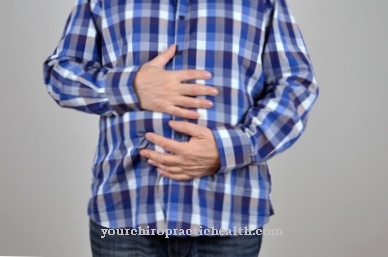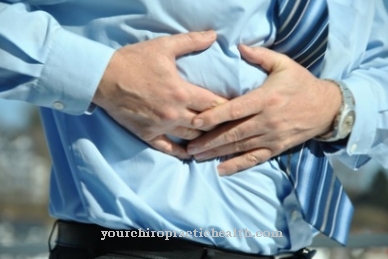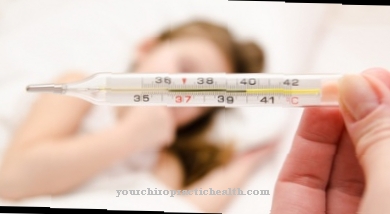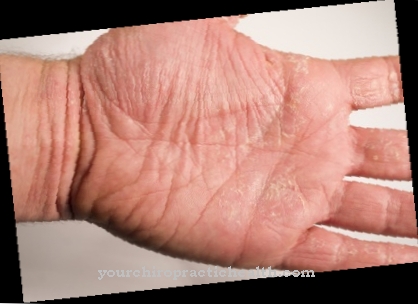Even if it bothers a lot of people, sweat production is vital. This is the only way to prevent the body from overheating. Sweat production plays an essential role in thermoregulation. Excessive armpit sweating However, it can become uncomfortable and also be a sign of illness.
What are the characteristics of excessive underarm sweating?

Sweat glands ensure that people sweat. The skin has around 2 million sweat glands, which are distributed over the entire surface of the body. Furthermore, the sweat forms a kind of protective acid mantle; in this way any pathogens can be repelled. Only the male glans and the lips have no sweat glands.
The highest concentration of sweat glands is found on the palms of the hands, the forehead and the soles of the feet. In sweat production, a distinction is made between nervous and thermoregulatory sweating. With thermoregulatory sweating, there is an increased body temperature and, as a result, an increased blood temperature. Nervous sweating, on the other hand, is triggered by emotions.
causes
The causes are varied. The production of sweat under the armpits mainly starts with physical exertion, warm clothes, very high outside temperatures or illnesses that are accompanied by fever, for example. However, a hereditary predisposition can sometimes be responsible. Even very overweight people sweat more often than people of normal weight.
Any tests, which may well “scare” those affected, can also lead to sweating. Another reason is a hormonal change. This can be triggered by menstruation, menopause or pregnancy. Medication can also be responsible for stimulating excessive sweating under the armpits.
In a few cases, however, frequent sweating is also a symptom of another disease. For example, neurological diseases (Parkinson's disease), rheumatism, heart attacks, as well as hypoglycaemia in diabetics and infectious diseases (tuberculosis, AIDS) or cancer (leukemia) can promote sweat production.
You can find your medication here
➔ Drugs against sweating and sweatingDiseases with this symptom
- Menopause
- Hyperhidrosis
- Diabetes mellitus
- Obesity
- leukemia
- Heart attack
- Parkinson's
- AIDS
- rheumatism
Diagnosis & course
Profuse sweating is very rarely a reason why a doctor is consulted. However, if there is excessive sweat production, which sometimes lasts longer and is perceived as extremely annoying, a medical diagnosis should very well be made. The doctor first does a blood test and then an ultrasound scan; if it is suspected that the excessive sweat production was triggered by cancer, a biopsy can be performed.
The doctor divides sweat production into three degrees. In Grade I, there is excessive moisture in the armpits; the sweat spots are between 5 and 10 centimeters in diameter. In grade II, the sweat stain under the armpits is 10 to 20 centimeters; grade III has a diameter of over 20 centimeters. Since the excessive production of sweat under the armpits is only a symptom, the course of the disease varies.
Complications
Complications of not treating excessive armpit sweating are functional and psychological. The sufferers wear certain types and colors of clothing to hide the sweat stains. In some sick people, the sweat production is so high that they have to change their clothes several times a day.
Another problem is the smell of sweat, as antiperspirants and deodorants only help in a few cases. Heavy armpit sweat creates social impairment. Everyday life, quality of life and interpersonal relationships suffer. When treating axillary hyperhidrosis, different complications arise, depending on the type of treatment.
When taking medication, vision problems, fatigue, dry mouth, problems using the toilet and hallucinations can occur. Disadvantages of the suction curettage are wound healing disorders, long-lasting swellings, infections, scarring and, in rare cases, complete dryness under the armpits.
Complications of the endoscopic sympathetic block are severe signs of fatigue, a slower heart rate and the occurrence of compensatory sweating, i.e. the patient sweats more in other parts of the body after the operation.
The biggest disadvantage of a Botox treatment is the time-limited duration of action. This means that this process has to be repeated every six to ten months. The injections can also be very painful. Some patients are not suitable for this form of therapy because they have antibodies against the toxin.
When should you go to the doctor?
Excessive perspiration is uncomfortable and stressful. It can be genetic as some people naturally sweat more than others. Although perspiration is a natural protective mechanism of the body, excess is problematic.
Going to the doctor is advisable if self-help measures such as regular washing, shaving under the armpits or wearing skin-friendly clothing do not work. In particular, if excessive sweating becomes a burden, a doctor should be consulted. One reason for this is, on the one hand, that those affected suffer themselves; on the other hand, it is conceivable that they will be excluded from the environment because of the odor nuisance, although they are not to be held responsible for it. For example, there can be talk at work.
The first address is the family doctor. After examining the problem, he can first initiate measures himself. But if the situation is more complex, he can arrange referrals to special experts. Excessive armpit sweating is sometimes due to too many sweat glands. These can be surgically removed. Only the specialist can decide whether this step makes sense or not. It is a surgical procedure that should be avoided if possible, but is sometimes unavoidable.
Doctors & therapists in your area
Treatment & Therapy
In many cases, individual measures are sufficient to reduce sweat production. This means that it is primarily important to ensure adequate personal hygiene. The patient should therefore use disinfectant soaps. Antiperspirants can also help - especially when it comes to the armpits. These are available as creams, solutions or powders and help patients when they sweat excessively.
This is because - only when the product is applied - the sweat glands contract. Deodorants and soaps also help to neutralize odors. Another way that excessive underarm sweat can be stopped or reduced is with sage. Sage tea is an effective home remedy, as sage causes the sweat glands to contract (like an antiperspirant).
Synthetic clothing should be avoided. It is also advisable to pay attention to the outside temperature and not wear excessively warm clothing if the person concerned sweats excessively or slightly. The diet should also be adjusted. Those who sweat heavily should avoid coffee, alcohol and spicy foods. These promote sweat production under the armpits.
A misconception: The amount you drink must not be reduced because the body loses water due to excessive sweat production, which it absolutely needs. So even more should be drunk so that the fluid secreted by the sweat glands can be replaced. If there is nervous sweating, relaxation techniques can sometimes help. For example, if the patient cannot cope with the sweat production and realizes that no self-measures help, professional therapy should be sought.
Finally, there is the option of conservative and surgical treatment methods. Iontophoresis is mainly used in conservative therapy. This is a direct current application in which the activity of the sweat glands is reduced. Botulinum toxin injections (better known as botox) can also help. Botox blocks the nerve lines that lead to the sweat glands.
Surgical therapies include the removal of the sweat glands (excision), the suction of the sweat glands (suction curettage) and the blocking of the sweat glands (sympathectomy). If there is another disease that is ultimately responsible for sweat production, the underlying disease must be treated.
Outlook & forecast
Excessive armpit sweating is often due to overactivity of the sweat glands. It can also affect other areas of the body, such as the palms of the hands. People who sweat excessively under the armpits for this reason most likely developed the problem around the onset of puberty, when the sweat glands began to become active.
Excessive armpit sweating will no longer go away on its own, unless it is just a temporary pubertal problem. Cases that occur at a young age can resolve with the end of puberty and the transition into adulthood, because then the hormones also settle down to normal levels.
Often, however, the problem persists into old age. It leads to further difficulties in everyday life, including visible sweat stains on clothing or a sweat odor that is difficult to combat with commercially available deodorant.
If those affected do not have the cause of the excessive sweating under the armpits treated, difficulties can arise again and again in the course of life due to the increased moisture under the arms. Careful personal hygiene is not only important to avoid odors, but also because a warm and humid environment promotes fungal infections. There may also be more blackheads on the skin as the pores become clogged more easily.
You can find your medication here
➔ Drugs against sweating and sweatingprevention
Excessive sweating cannot be prevented - provided tips for self-help are used - but it can be reduced. However, if there is a disease that promotes excessive sweat production, this symptom cannot be prevented.
You can do that yourself
Various home remedies and measures can help against excessive sweating under the armpits. It is often enough to wear loose clothing and avoid direct contact with the sun. If the outside temperature is high, you should not shower too hot in the morning. Alternating showers with hot and cold water can be used in the evening. Antiperspirants narrow the pores and can be applied directly after body care for an optimal effect.
Perspiration can also be reduced by taking in sufficient fluids and avoiding spicy or hot food and drinks. Effective natural remedies include sage, thyme and oak leaves. A brew or tea made from these plants regulates body temperature and inhibits perspiration. A household alternative is tomato juice. When added to bath water, the contained enzymes inhibit the development of sweat and also strengthen the upper layers of the skin.
Apple cider vinegar or rubbing alcohol, rubbed under the armpits with a cloth, also promise acute help. If you want to stop the flow of sweat immediately, you should wash your armpits several times a day with lukewarm water. Acupressure can also help: a massage between the ear lobes and the skull bones inhibits the production of sweat under the armpits and ensures a better general feeling of wellbeing.
↳ More information: 10 tips against sweating



























